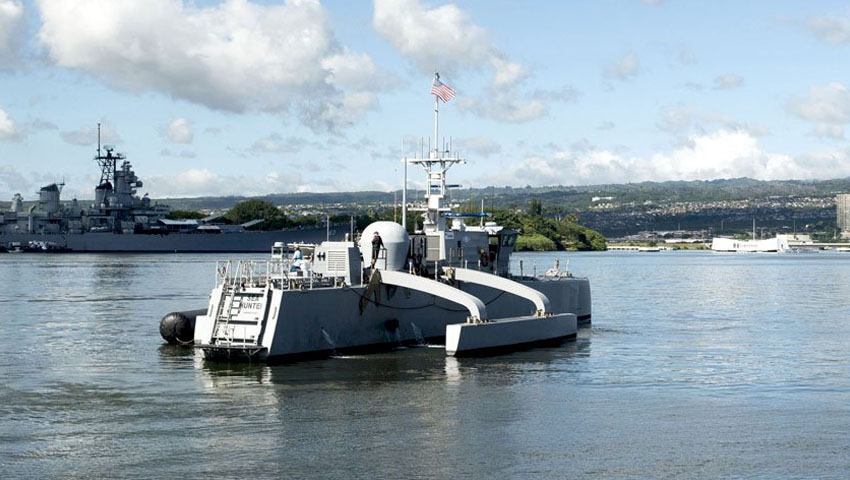US President Joe Biden’s recent defence budget request falls short of advancing the US Navy’s growth ambitions, according to one intelligence officer.
To continue reading the rest of this article, please log in.
Create free account to get unlimited news articles and more!
Last month, US President Joe Biden proposed US$715 billion in Defence spending for the 2022 financial year (FY22), up 11.3 per cent from FY21.
Secretary of Defense Lloyd Austin insisted that the request was sufficient enough to advance the US’s strategic objectives.
"This budget provides us the ability to create the right mix of capabilities to defend this nation and to deter any aggressors," Secretary Austin said.
"It adequately allows us to begin to prepare for the next fight.
“[It] in fact does provide us the ability to go after the capabilities that we need."
However, according to Nick Danby, an intelligence officer in the US Navy, the spending commitment does not match the country’s ambitions in the maritime domain.
Just under 23 per cent of the funds (US$163.9 billion) were apportioned for the Navy, however, Danby claims this would not guarantee a naval force “robust” enough to counter the growing threat posed by China.
“Bottom line up front — the Biden administration wants the US Navy to do more — defending allied territorial claims in the South China Sea, deterring a Chinese invasion of Taiwan and maintaining freedom of navigation — with less,” Danby writes in a piece published by the Australian Strategic Policy Institute (ASPI).
The FY22 request proposes a naval procurement spending decrease of 5.7 per cent to help fund a 3.4 per cent increase in operation and maintenance, a 3.5 per cent increase in personnel, a 12.4 per cent increase in research and development, and a 13.9 per cent increase in infrastructure accounts.
Danby observes that this reflects a “shift in priorities” from the Navy to preference innovation and modernisation.
“At first glance, the allocations make fiscal and strategic sense. Like professional American sports teams that trade star players for young upstarts to ensure future victories, the US Navy is undergoing a ‘rebuilding year’,” he continues.
“Axing legacy systems and ships that are incompatible with a threat environment marked by great-power competition frees up cash to bolster R&D for new technologies that could deliver ‘new, warfighting advantages to our forces, including artificial intelligence, hypersonic technology and cyber capabilities’.
“A decade of procurement delays, shortfalls and design errors warrants a doubling-down on R&D to ensure the navy builds future ships, aircraft, weapons and other assets without debilitating postponements or problems.”
However, Danby argues that “rapidly robbing” procurement to fund maintenance, readiness and research is not sustainable.
Danby notes that FY22’s proposed procurement would only fund the delivery of eight new ships — half the number China plans to develop over the same period.
“Such meagre production (coupled with the planned retirement of 15 other ships) will once again keep the US Navy at 296 ships and halt any plans to expand the fleet,” he adds.
“This dangerous proclivity to sacrifice procurement for other priorities is beginning to contravene and undermine long-term strategic planning.”
Danby references the US Navy’s new ‘distributed lethality’ philosophy, which focuses on enhancing the “offensive and defensive capability of individual warships”, employing vessels in “dispersed formations across a wide expanse of geography”, and “generating distributed fires”.
However, he claims the current fleet “lacks the strength, mobility and firepower to execute this strategy”.
“That’s why it desires a bigger, ‘more agile and distributed’ fleet with more unmanned or smaller platforms and fewer large, expensive platforms,” he continues.
Accordingly, the Navy has set a 355-ship target by the 2030s, which became law under the National Defense Authorization Act (2018).
Former defense secretary Mark Esper later increased the target to 500 manned and unmanned vessels by 2045.
But Danby notes that this target is not achievable under the current rate of production.
“The Navy needs to recapitalise procurement at 10 ships per year to satisfy that benchmark, let alone Esper’s plan,” he writes.
“This wouldn’t be an issue if FY22’s shipbuilding projections were an anomaly. But they’re not.”
Danby argues that the FY22 budget request represents another ‘rebuilding’ year for the US Navy.
“Last year, the Navy also requested eight ships after reducing shipbuilding procurement by 17 per cent to reinvest in operations, maintenance and R&D. Sound familiar?” he writes.
“[At] some point, the US Navy is going to have to stop rebuilding and start building, competing and winning.”
The intelligence officer notes that no timetable has been set for a shift in the Pentagon’s agenda, with this year’s budget released without a five-year plan — the Future Years Defense Program (FYDP).
“Without a long-term projection from the Biden administration on the force’s future size, the Navy will have even less impetus to increase procurement spending,” Danby writes.
“The fulfilment of long-term strategic ambitions rarely pairs well with short-term planning.”
Danby points out that despite the underwhelming budget request, Congress would likely increase Navy spending to fund more shipbuilding in FY22, including another Flight III Arleigh Burke Class destroyer and more Constellation Class frigates and unmanned vessels.
“[Congress] also must set a deadline for the Biden administration to release the long-term plan (or FYDP) to grow the fleet to 355 ships by the early 2030s, which Chief of Naval Operations Admiral Michael Gilday still considered ‘a really good target’ in April,” he writes.
“Rebuilding to develop the tools for a highly capable naval force is important, but so is building and deploying that force.”
Danby concludes: “Biden is right. The US must ‘compete more strenuously’ in this century. But the Navy’s FY22 budget request isn’t just uncompetitive, it’s insufficient.”
Nick Danby’s views are his own, and do not necessarily reflect the views of the US Navy.
Get involved with the discussion and let us know your thoughts on Australia's future role and position in the Indo-Pacific region and what you would like to see from Australia's political leaders in terms of partisan and bipartisan agenda setting in the comments section below, or get in touch with
Charbel Kadib
News Editor – Defence and Security, Momentum Media
Prior to joining the defence and aerospace team in 2020, Charbel was news editor of The Adviser and Mortgage Business, where he covered developments in the banking and financial services sector for three years. Charbel has a keen interest in geopolitics and international relations, graduating from the University of Notre Dame with a double major in politics and journalism. Charbel has also completed internships with The Australian Department of Communications and the Arts and public relations agency Fifty Acres.

 Login
Login








